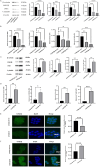GSK3β serves as a novel therapeutic target in patients with type 2 diabetes mellitus complicated by colorectal cancer
- PMID: 40821070
- PMCID: PMC12351593
- DOI: 10.62347/TQUD3910
GSK3β serves as a novel therapeutic target in patients with type 2 diabetes mellitus complicated by colorectal cancer
Abstract
In clinical practice, tumor occurrence and progression appear to be more frequent and rapid in patients with type 2 diabetes mellitus (T2DM) compared to non-diabetic individuals. Epidemiological studies have confirmed that the incidence of colorectal cancer (CRC) is relatively higher in patients with T2DM. However, the key candidate regulatory factors that mediate and drive the concurrent development and progression of T2DM and CRC remain unclear. Analysis using the Significant Bias Evaluation Method on clinical data revealed that patients with T2DM have a higher propensity for developing lung cancer, colorectal cancer, and breast cancer. Further analysis of the key factors associated with T2DM and related tumors identified GSK3β as a potential key regulatory factor in CRC development in T2DM patients, through differential expression analysis using the limma package on real-world data. Western blot and qRT-PCR validation revealed that, compared to the non-insulin-resistant HT29 CRC cell line group, the mRNA and protein expression levels of GSK3β were significantly elevated in the insulin-resistant group. Similarly, the mRNA and protein expression levels of factors associated with the GSK3β-β-catenin-CyclinD1/cMyc pathway were also upregulated. Furthermore, when GSK3β was silenced or overexpressed, the proliferative effect of tumor cells was markedly reduced or increased, respectively. In summary, GSK3β is upregulated in T2DM patients with CRC and contributes to tumor progression. GSK3β holds promise as a novel therapeutic target for the treatment of patients with T2DM complicated by CRC, potentially providing a solution to address clinical challenges.
Keywords: GSK3β; Type 2 diabetes mellitus; bioinformation; colorectal cancer.
AJTR Copyright © 2025.
Conflict of interest statement
None.
Figures




Similar articles
-
Prescription of Controlled Substances: Benefits and Risks.2025 Jul 6. In: StatPearls [Internet]. Treasure Island (FL): StatPearls Publishing; 2025 Jan–. 2025 Jul 6. In: StatPearls [Internet]. Treasure Island (FL): StatPearls Publishing; 2025 Jan–. PMID: 30726003 Free Books & Documents.
-
Preexisting Diabetes and Pregnancy: An Endocrine Society and European Society of Endocrinology Joint Clinical Practice Guideline.Eur J Endocrinol. 2025 Jun 30;193(1):G1-G48. doi: 10.1093/ejendo/lvaf116. Eur J Endocrinol. 2025. PMID: 40652450
-
A rapid and systematic review of the clinical effectiveness and cost-effectiveness of paclitaxel, docetaxel, gemcitabine and vinorelbine in non-small-cell lung cancer.Health Technol Assess. 2001;5(32):1-195. doi: 10.3310/hta5320. Health Technol Assess. 2001. PMID: 12065068
-
Contrast-enhanced ultrasound using SonoVue® (sulphur hexafluoride microbubbles) compared with contrast-enhanced computed tomography and contrast-enhanced magnetic resonance imaging for the characterisation of focal liver lesions and detection of liver metastases: a systematic review and cost-effectiveness analysis.Health Technol Assess. 2013 Apr;17(16):1-243. doi: 10.3310/hta17160. Health Technol Assess. 2013. PMID: 23611316 Free PMC article.
-
Selenium for preventing cancer.Cochrane Database Syst Rev. 2018 Jan 29;1(1):CD005195. doi: 10.1002/14651858.CD005195.pub4. Cochrane Database Syst Rev. 2018. PMID: 29376219 Free PMC article.
References
-
- Vulichi SR, Runthala A, Begari N, Rupak K, Chunduri VR, Kapur S, Chippada AR, Sistla DSM. Type-2 diabetes mellitus-associated cancer risk: in pursuit of understanding the possible link. Diabetes Metab Syndr. 2022;16:102591. - PubMed
-
- Chen L, Zhou Y, Yan G, Shen Y, Sun C, Cai W, Chu M, Xiao J. Risk of malignant tumor in patients with type 2 diabetes: a prospective population-based study. Chinese General Practice. 2023;26:3238–3245.
-
- Pearson-Stuttard J, Bennett J, Cheng YJ, Vamos EP, Cross AJ, Ezzati M, Gregg EW. Trends in predominant causes of death in individuals with and without diabetes in England from 2001 to 2018: an epidemiological analysis of linked primary care records. Lancet Diabetes Endocrinol. 2021;9:165–173. - PMC - PubMed
-
- Huan W. Analysis and mechanism of patients with type 2 diabetes in Changchun. The First Bethune Hospital Jilin University; 2023. [Thesis]
LinkOut - more resources
Full Text Sources
